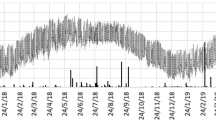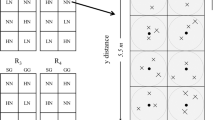Abstract
Soil analyses were conducted on home lawns across diverse ecoregions of the U.S. to determine the soil organic carbon (SOC) sink capacity of turfgrass soils. Establishment of lawns sequestered SOC over time. Due to variations in ecoregions, sequestration rates varied among sites from 0.9 Mg carbon (C) ha−1 year−1 to 5.4 Mg C ha−1 year−1. Potential SOC sink capacity also varied among sites ranging from 20.8 ± 1.0–96.3 ± 6.0 Mg C ha−1. Average sequestration rate and sink capacity for all sites sampled were 2.8 ± 0.3 Mg C ha−1 year−1 and 45.8 ± 3.5 Mg C ha−1, respectively. Additionally, the hidden carbon costs (HCC) due to lawn mowing (189.7 kg Ce (carbon equivalent) ha−1 year−1) and fertilizer use (63.6 kg Ce ha−1 year−1) for all sites totaled 254.3 kg Ce ha−1 year−1. Considering home lawn SOC sink capacity and HCC, mean home lawn sequestration was completely negated 184 years post establishment. The potential SOC sink capacity of home lawns in the U.S. was estimated at 496.3 Tg C, with HCC of between 2,504.1 Gg Ce year−1 under low management regimes and 7551.4 Gg Ce year−1 under high management. This leads to a carbon-positive system for between 66 and 199 years in U.S. home lawns. More efficient and reduction of C-intensive maintenance practices could increase the overall sequestration longevity of home lawns and improve their climate change mitigation potential.

Similar content being viewed by others
References
Bandarnayake W, Qian YL, Parton WJ, Ojima DS, Follett RF (2003) Estimation of soil organic carbon changes in turfgrass systems using the CENTURY model. Agron J 95:558–563
Batty JC, Keller J (1980) Energy requirements for irrigation. In: Pimentel D (ed) Handbook of energy utilization in agriculture. CRC Lewis Publishers, Boca Raton, pp 35–44
Beard JB, Green RL (1994) The role of turfgrasses in environmental protection and their benefits to humans. J Environ Qual 23:1–18
Blake GR, Hartage KH (1986) Bulk density. In: Kulte A (ed) Methods of soil analysis, part I, 2nd edn. Agronomy monographs 9. ASA and SSSA, Madison, pp 363–375
Blancomontero CA, Bennett TB, Neville P, Crawford CS, Milne BT, Ward CR (1995) Environmental and economic impacts of turfgrass in Albuquerque, New Mexico (USA). Landsc Ecol 10:121–128
Bohn H, McNeal B, O’Connor G (1985) Soil chemistry, 2nd edn. Wiley, New York
Boustead I, Hancock GF (1979) Handbook of industrial energy analysis. Horwood, Chichester
Brown JR (1994) The Sanborn field experiment. In: Leigh RA, Johnson AE (eds) Long- term experiments in agriculture and ecological sciences. CAB International, Wallingford, pp 39–51
Buyanovsky GA, Wagner GH (1998) Carbon cycling in cultivated land and its global significance. Glob Change Biol 4:131–141
Conant RT, Paustian K, Elliott ET (2001) Grassland management and conversion into grassland: effects on soil carbon. Appl Ecol 11:343–355
Davidson EA, Ackerman IL (1993) Changes in soil carbon inventories following cultivation of previously untilled soils. Biogeochemistry 20:161–193
Falk JH (1976) Energetics of a suburban lawn ecosystem. Ecology 57:141–150
Fluck RC (1992) Energy in farm production. In: Fluck RC (ed) Energy in world agriculture, 6th edn. Elsevier, New York, pp 218–267
Gebhart DL, Johnson HB, Mayeux HS, Polley HW (1994) The CRP increases soil organic carbon. Soil Water Conserv 49:488–492
Gold AJ, Groffman PM (1993) Leaching of agrichemicals from suburban areas. ACS Symp Ser 522:182–190
Gross CM, Angle JS, Welterlen MS (1990) Nutrient and sediment losses from turfgrass. J Environ Qual 19:663–668
Haynes RJ, Swift RS, Steohen RC (1991) Influence of mixed cropping rotations (pasture-arable) on organic matter content, water stable aggregation and clod porosity in a group of soils. Soil Tillage Res 19:77–81
Huh KY, Deurer M, Sivakumaran S, McAuliffe K, Bolan NS (2008) Carbon sequestration in urban landscapes: the example of a turfgrass system in New Zealand. Aust J Soil Res 46:610–616
Kennedy P, Kennedy H, Papadimitriou S (2005) The effect of acidification on the determination of organic carbon, total nitrogen, and their stable isotopic composition in algae and marine sediment. Rapid Commun Mass Spectrom 19:1063–1068
Lal R (2004) Carbon emissions from farm operations. Environ Int 30:981–990
Lal R, Bruce JP (1999) The potential of world cropland soils to sequester C and mitigate the greenhouse effect. Environ Sci Pol 2:177–185
Mensah F, Schoenau JJ, Malhi SS (2003) Soil carbon changes in cultivated and excavated land converted to grasses in east-central Saskatchewan. Biogeochemistry 63:85–92
Meyer MH, Behe BK, Heilig J (2001) The economic impact and perceived environmental effect of home lawns in Minnesota. Hortic Technol 11:585–590
Murty D, Kirschbaum MUF, McMurtrie RE, McGilvray H (2002) Does forest conversion to agricultural land change soil organic carbon and nitrogen? A review of the literature. Glob Change Biol 8:105–123
Ogle SM, Breidt FJ, Eve MD, Paustian K (2003) Uncertainty in estimating land use and management impacts on soil organic storage for US agricultural lands between 1982 and 1997. Glob Change Biol 9:1521–1542
Pendall R (1999) Do land-use controls cause sprawl? Environ Plan B 26:555–571
Petrovic AM (1990) The fate of nitrogenous fertilizers applied to turfgrass. J Environ Qual 19:1–14
Qian YL, Follett RF (2002) Assessing soil carbon sequestration in turfgrass systems using long-term soil testing data. Agron J 94:930–935
Qian YL, Follett RF, Kimble JM (2010) Soil organic carbon input from urban turfgrasses. Soil Sci Soc Am J 74:366–371
Sahu R (2008) Technical assessment of the carbon sequestration potential of managed turfgrass in the United States. Research report. Accessed 1 Nov 2008. http://members.opei.org/dotAsset/15570.pdf
Selhorst AL, Lal R (2011) Carbon budgeting in golf course soils of Central Ohio. Urban Ecosyst 14:771–781
Shahba M (2010) Interaction effects of salinity and mowing on performance and physiology of Bermudagrass cultivars. Crop Sci 50:2620–2631
Sloggett G (1979) Energy use and U.S. agriculture: irrigation pumping 1974–1977. Agriculture economic report #436. U.S.D.A, Washington DC
Tyson KC, Roberts DH, Clement CR, Garwood EA (1990) Comparison of crop yields and soil conditions during 30 years under annual tillage or grazed pasture. J Agric Sci 115:29–40
United States Census Bureau (2009) American housing survey: 2009. Accessed 3 March 2011. http://www.census.gov/hhes/www/housing/ahs/ahs09/ahs09.html
United States Department of Agriculture-Natural Resource Conservation Service (USDA-NRCS) (1996) Soil survey laboratory methods manual. USDA-NRCS, Washington DC
United States Environmental Protection Agency (US EPA) (2012) Inventory of U.S. greenhouse gas emissions and sinks: 1990–2010. Accessed 26 July 2012. http://www.epa.gov/climatechange/Downloads/ghgemissions/US-GHG-Inventory-2012Main-Text.pdf
Wilson WS (ed) (1991) Advances in soil organic matter research: the impact of agriculture and the environment. Royal Society of Chemistry, Cambridge, pp 410
Witteveen G, Bavier M (2005) Practical golf course maintenance: the magic of greenkeeping. Wiley, Hoboken, p 240
Acknowledgments
We thank the Environmental Science Graduate Program at The Ohio State University and Scotts Lawn Service for supporting this research. Additionally, this material is based upon work supported by the National Science Foundation under grant DGE-0638669. Any opinions, findings, and conclusions or recommendations expressed in this material are those of the author and do not necessarily reflect the views of the National Science Foundation. We are also grateful to all of the home owners for allowing us the time and use of their land for soil sampling. Additional consideration goes out to Bruce Augustin for advice regarding sampling locations and techniques as well as Klaus Lorenz and Basant Rimal who aided in the C analysis.
Author information
Authors and Affiliations
Corresponding author
Rights and permissions
About this article
Cite this article
Selhorst, A., Lal, R. Net Carbon Sequestration Potential and Emissions in Home Lawn Turfgrasses of the United States. Environmental Management 51, 198–208 (2013). https://doi.org/10.1007/s00267-012-9967-6
Received:
Accepted:
Published:
Issue Date:
DOI: https://doi.org/10.1007/s00267-012-9967-6




